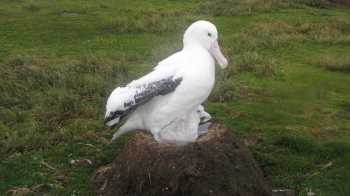Writing in the journal Environmental Pollution Silvia Taveres (Centre for Functional Ecology, Department of Life Sciences, University of Coimbra, Portugal) and colleagues report on mercury levels in Wandering Albatrosses Diomedea exulans.
The paper’s abstract follows:
“Although mercury bio-amplifies through the food chain and accumulates in top predators, mercury concentrations in tissues of the wandering albatross are greater than in any other vertebrate, including closely related species. In order to explore the alternative explanations for this pattern, we measured total mercury concentrations in feathers, plasma and blood cells of wandering albatrosses of known age, sex and breeding status sampled at South Georgia. Mercury concentrations were low in feathers and blood components of chicks, and higher in the feathers of young pre-breeders than in feathers or blood of older pre-breeders and breeding adults. There was no effect of sex on mercury concentrations in the feathers of pre-breeders or breeding adults, whereas levels were significantly higher in blood cells of breeding females than males. The high feather mercury concentrations of young pre-breeders compared with older birds suggest an increase in moult frequency as birds approach maturity.”

A Wandering Albatross broods its chick. Photograph by John Cooper
Reference:
Xavier, J.C., Phillips, R.A., Pereira, M.E. & Pardal, M.A. 2013. Influence of age, sex and breeding status on mercury accumulation patterns in the wandering albatross Diomedea exulans. Environmental Pollution.
John Cooper, ACAP Information Officer, 24 July 2013

 English
English  Français
Français  Español
Español